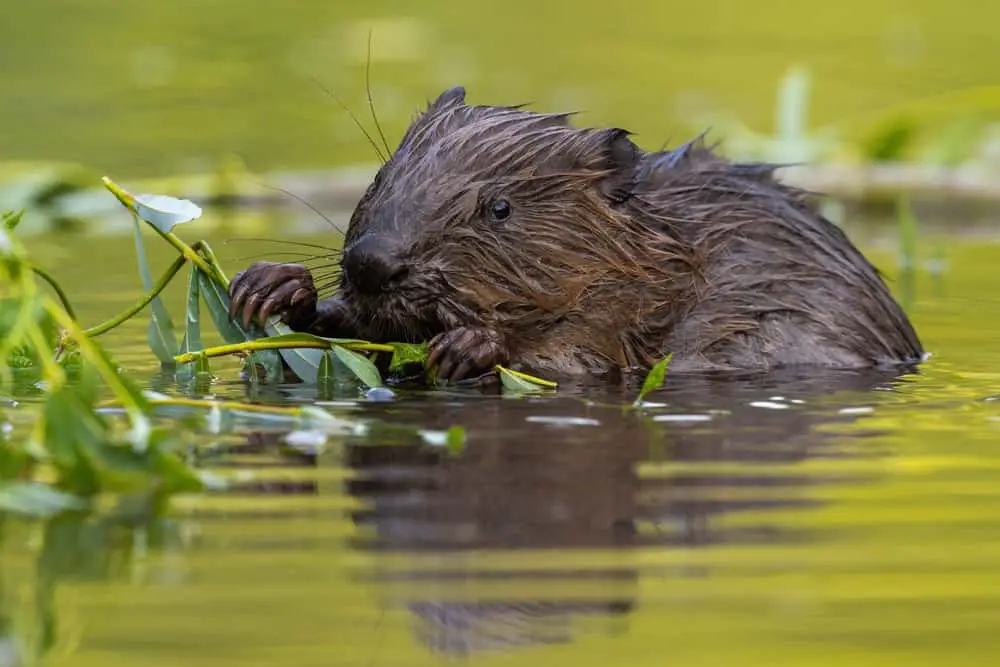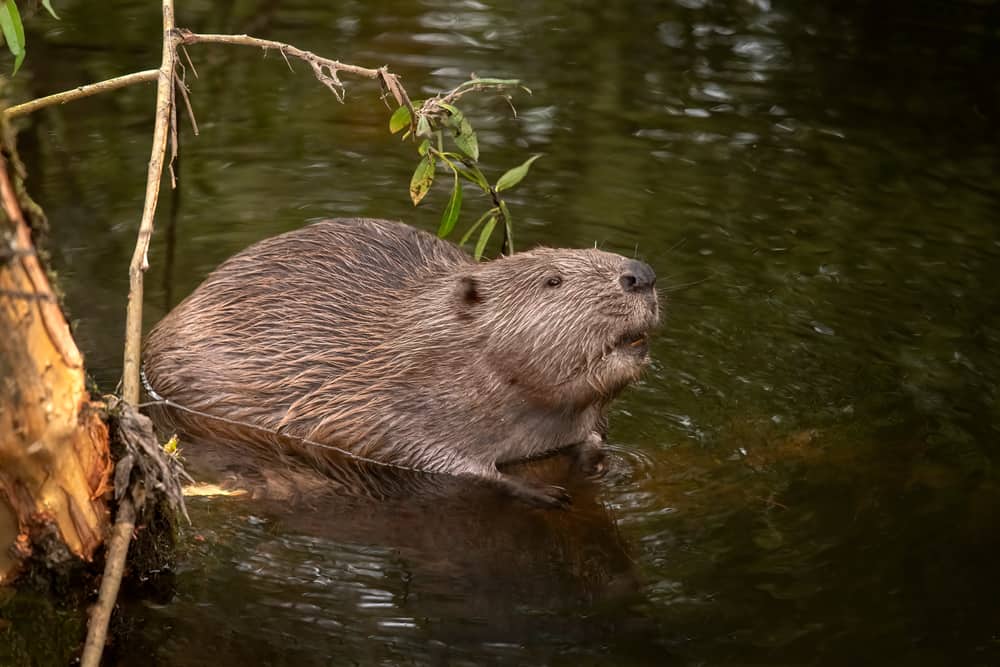Beavers (Castor canadensis) are known for their unique ability to construct dams, canals, and lodges in freshwater ecosystems. They play a significant role in shaping wetland environments by creating habitats for other species.
Beavers are widespread across North America, Europe, and Asia. These semi-aquatic rodents have been revered by indigenous peoples for centuries due to their cultural significance as well as their fur trade value.
In recent times, beavers have gained attention from ecologists due to their important ecological roles that include regulation of water flow, reduction of erosion, nutrient cycling, and carbon storage. Despite this importance, human activities such as habitat loss and hunting have led to population declines in some regions.
As such, understanding the biology and ecology of these fascinating animals is crucial towards developing effective conservation strategies.

Taxonomy And Classification
The beaver is a large semi-aquatic rodent species that belongs to the genus Castor within the family Castoridae.
This family consists of two extant species: C. canadensis and C. fiber, both of which are native to North America and Eurasia respectively.
The evolutionary history of beavers dates back around 40 million years when they were found in Europe and Asia during the Oligocene epoch.
Beavers have been studied for their genetic diversity due to their wide distribution across different ecological regions.
Genetic studies have revealed that there is significant divergence between populations living on separate continents, as well as among subpopulations residing within similar habitats.
These findings suggest that genetic differentiation may have arisen as a result of geographical isolation or environmental factors affecting local selection pressures.
Despite this divergence, beavers continue to play an essential role in maintaining aquatic ecosystems worldwide through dam building activities that create wetlands and improve water quality.
Physical Characteristics And Behavior
As discussed in the previous section, taxonomy and classification are essential aspects of understanding the diversity of animal species. In this section, we will delve into the physical characteristics and behavior of beavers.
Beavers belong to the family Castoridae and are one of the largest rodents found in North America. These semi-aquatic animals have a unique adaptation strategy that enables them to thrive in their aquatic habitat. Beavers are known for their impressive engineering skills as they build dams using sticks, logs, and mud. The construction of these dams creates deep ponds that serve as protection from predators while also providing easy access to food sources such as bark and leaves.
Furthermore, beavers’ social structure is highly organized with each colony consisting of a breeding pair and their offspring. Younger members assist in building, maintaining, and repairing dams which helps reinforce relationships within the group. Overall, beavers possess remarkable abilities that allow them to adapt well to their environment making them an important part of ecosystems where they reside.
How Good Are the Senses of a Beaver: Discovering the Sensory Abilities of Beavers
Habitat And Distribution
The beaver is a semiaquatic mammal that is native to North America and Eurasia. These animals are known for their unique ability to construct dams, lodges, and canals in freshwater environments.
The geographical range of the beaver includes much of Canada, Alaska, and the northern regions of the United States. In Europe, they can be found throughout Russia and Scandinavia.
In terms of habitat preference, beavers typically reside near aquatic ecosystems such as rivers, streams, and ponds. They require a steady source of water to survive since they use it both for drinking purposes and for creating their elaborate structures.
Beavers are an important part of many wetland ecosystems due to their role in altering water levels, which can influence plant growth and provide habitats for other species.
Beavers’ Predators Exposed: A Look into the Food Chain
Ecological Roles And Importance
Beaver dams are one of the most prominent ecological structures that can be found in freshwater ecosystems. These dams, made by beavers through cutting trees and branches, serve as a home for them while also providing habitat for other aquatic organisms. Additionally, these dams significantly alter water flow and create wetlands which benefits plant growth and provides breeding grounds for fish.
Furthermore, beavers have been classified as keystone species due to their significant impact on the ecosystem they inhabit. They affect both the physical landscape of an area and its biodiversity. Beaver-made ponds and wetlands act as catchments for runoff water during heavy rain which mitigates flooding downstream. Moreover, these wetlands provide food sources for various animals such as birds, otters, muskrats, among others.
Without beavers’ existence within an ecosystem:
- Water flow would remain stagnant
- Wetland habitats would not exist
- Ecosystem services like flood mitigation would decrease
Therefore, it is crucial to recognize the importance of beavers in maintaining a healthy ecosystem. Their activities lead to increased biodiversity that ultimately leads to better environmental health overall.
Threats And Conservation Efforts
One of the major threats to beavers is poaching, which occurs mainly for their fur. Beaver pelts were highly valued in the 17th and 18th centuries, leading to a significant decline in their population. While hunting has been greatly reduced since then, illegal poaching still exists today due to the high demand for beaver fur in certain parts of the world. To combat this threat, various measures have been implemented such as stricter laws against trapping without permits and increased enforcement efforts.
Another important conservation effort for beavers is habitat restoration. Due to human activities like logging and damming rivers, many areas where beavers once thrived are no longer suitable habitats. Habitat loss affects not only beavers but also many other species that rely on wetland ecosystems. Restoration projects involve creating artificial ponds or removing dams that prevent water from flowing freely, allowing natural processes to take place and providing new homes for beavers. Such efforts have proven successful in bringing back healthy populations of these creatures while benefiting entire ecosystems at the same time.
| Threats | Prevention Measures |
|---|---|
| Poaching | Stricter laws against trapping without permits |
| Increased enforcement efforts | |
| Habitat Loss | Creating artificial ponds |
| Removing dams that prevent water flow | |
| Restoring destroyed wetlands |
Human-Beaver Interactions
Beavers are known to modify their habitats through the construction of dams, which have far-reaching effects on local ecosystems. In many cases, human populations have come into contact with beavers due to these modifications, leading to both positive and negative interactions between the two species. From a conservation perspective, it is important to understand these interactions in order to better manage resources and protect both humans and wildlife.
One notable aspect of human-beaver interactions throughout history has been the fur trade. Beavers were once highly valued for their pelts, which were used as a source of warmth and fashion accessories. This led to widespread hunting that nearly drove some beaver populations to extinction. Today, regulations exist in many countries aimed at preserving beaver populations while still allowing for sustainable use of their fur. Additionally, there has been an increased recognition of the importance of beavers in maintaining healthy wetland ecosystems through their dam-building activities.
Beaver Dams:
- Positive impacts – creation of wetlands provides habitat for other species
- Negative impacts – flooding can cause damage to infrastructure
- Management strategies – flow devices can be installed to regulate water levels
Beaver Fur Trade:
- Historical significance – major driver of exploration and settlement in North America
- Conservation concerns – overhunting causing population declines
- Current management practices – regulated trapping seasons and limits
Human-Wildlife Conflict:
- Common issues – damage caused by beaver activity (e.g., tree cutting)
- Mitigation methods – fencing or wrapping trees with wire mesh
- Coexistence strategies – installation of ‘beaver deceivers’ that prevent damming near infrastructure
Overall, while human-beaver interactions have had complex consequences throughout history, modern efforts aim towards balancing conservation needs with economic interests. By continuing to study these interactions and implementing effective management practices, we can ensure that both humans and beavers can coexist in a healthy and sustainable manner.

Conclusion
The beaver belongs to the family Castoridae, which includes two extant species of large rodents.
Beavers are well-known for their ability to construct dams and lodges using branches, mud, and rocks.
These structures provide habitat for a variety of aquatic animals and help regulate water flow in streams and rivers.
Beavers have a distinct set of physical characteristics that make them adept at living in aquatic environments.
Their webbed feet allow them to swim efficiently, while their thick fur insulates against cold temperatures.
Additionally, beavers possess powerful jaws capable of gnawing through trees with ease.
Despite being hunted extensively for their pelts during the 19th century, beaver populations have rebounded due to conservation efforts.
While humans often view beavers as pests due to their habit of damming up culverts and flooding roads or farmland, these creatures play an important role in maintaining healthy ecosystems.
By creating ponds and wetlands, they increase biodiversity by providing habitat for fish, amphibians, birds, and other wildlife.
Furthermore, the slow-moving water behind a beaver dam allows sediment to settle out, improving water quality downstream.
One possible objection to the importance of beavers is that human-made structures like reservoirs can accomplish many of the same benefits without interfering with infrastructure or private property.
While it is true that artificial wetlands can serve some ecological functions similar to those created by beavers, there are limitations to this approach.
For example, natural systems tend to evolve over long periods of time in response to changing environmental conditions whereas man-made ones cannot adapt nearly as quickly or easily.
Therefore preserving wild spaces inhabited by native species such as beavers is crucial not only from an ethical standpoint but also because it ensures ecosystem stability into the future.

